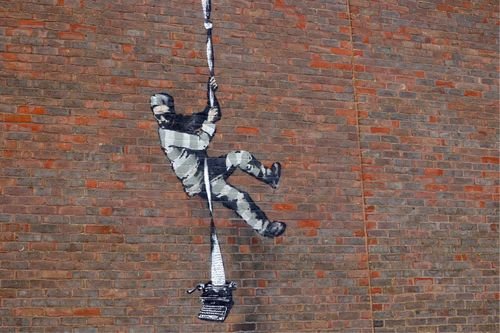Is Banksy behind this prison-escape mural on the wall of a notorious British jail?

An artwork depicting a prisoner’s daring escape has appeared on the wall of a British jail, prompting excited speculation that it was painted by elusive street artist Banksy.
The mural shows a prison inmate making an escape from Reading Prison, a disused institution in southern England that once held the Irish poet Oscar Wilde.
Its style matches the work of street art’s most enigmatic star, but there has been no confirmation yet that Banksy is behind it.
The mysterious work likely depicts Wilde, danging over the wall of the jail on sheets from his typewriter.
He was held at the institution, then known as Reading Gaol, for two years from 1895, after being imprisoned under a historical law against “gross indecency” that was used to prosecute gay men. Wilde’s 1898 poem “The Ballad of Reading Gaol” is a reflection on his time there.
The prison closed in 2013.
In December, Banksy confirmed that he was behind a new mural in Bristol, the English city that many believe is his hometown.
The mural, which the artist dubbed “Aachoo!!,” depicts an old woman violently sneezing, her dentures shooting through the air.
Banksy confirmed the work was his on his Instagram page, the usual forum on which he verifies artworks. No other works have been verified there since.
But he has been busy during the past year, dropping a handful of pandemic-inspired works.
In April, he posted a set of images to Instagram showing riotous rats graffitied around his bathroom. In a nod to those adjusting their lifestyle due to Covid-19, the artist added the caption: “My wife hates it when I work from home.”
The following month, he honored health care workers with an image titled “Game Changer,” which featured a child playing with a nurse doll wearing a mask and cape.
And in July, the artist posted an Instagram video showing himself spray-painting an image of a rat onto a London Underground train, as he urged people to wear face masks. It was later removed by transportation authorities for violating their “strict anti-graffiti policy.”